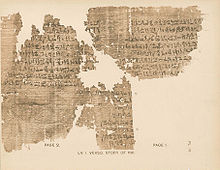The tale of Hai
The story of Hai is an extremely fragmentary work of ancient Egyptian literature . The modern name of the story is derived from the only person named, a man named Hai ( H3j ), who is probably not the protagonist .
Lore
The story is only on the back of the Al-Lahun papyrus Kahun LV. 1 handed down. This also contains some hymns to Pharaoh Sesostris III on its front . Both these hymns and the location allow the papyrus to be dated to the late 12th dynasty .
content
Due to the poor state of preservation, the content of the story is practically impossible to understand. Only 27 lines have survived, all of which have gaps. All that can be read from the scraps of text is that someone is giving a speech and that a person is murdered and then buried. The preserved text closes with the words “It is over”, from which it can be concluded that with the preserved lines only the end of the narrative has been passed on, while the beginning is completely missing.
The action probably took place at the time of the late Old Kingdom in Memphis , since the " Pyramid of Neferkare " ( Pepi II. ) Is mentioned. In addition to Hai, only one district chief is named, who may be the actual protagonist and who is probably responsible for the shark's burial.
literature
- Günter Burkard, Heinz J. Thissen: Introduction to the ancient Egyptian literary history I. Old and Middle Kingdom (= introductions and source texts for Egyptology. Vol. 1). Lit, Münster / Hamburg / London 2003, ISBN 978-3-8258-6132-2 , p. 201.
- Francis Llewellyn Griffith : The Petrie Papyri. Hieratic Papyri from Kahun and Gurob. Vol. 1: Text. Quaritch, London 1898, p. 4 ( PDF; 4.0 MB ).
- Francis Llewellyn Griffith: The Petrie Papyri. Hieratic Papyri from Kahun and Gurob. Vol. 2: Plates. Quaritch, London 1898, plate 4 ( PDF; 8.2 MB ).
